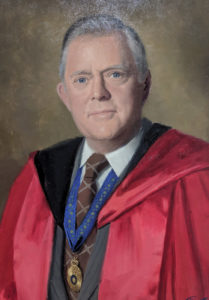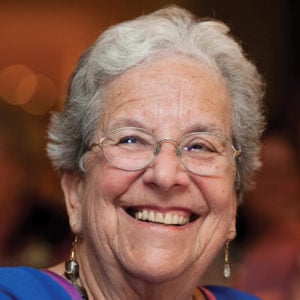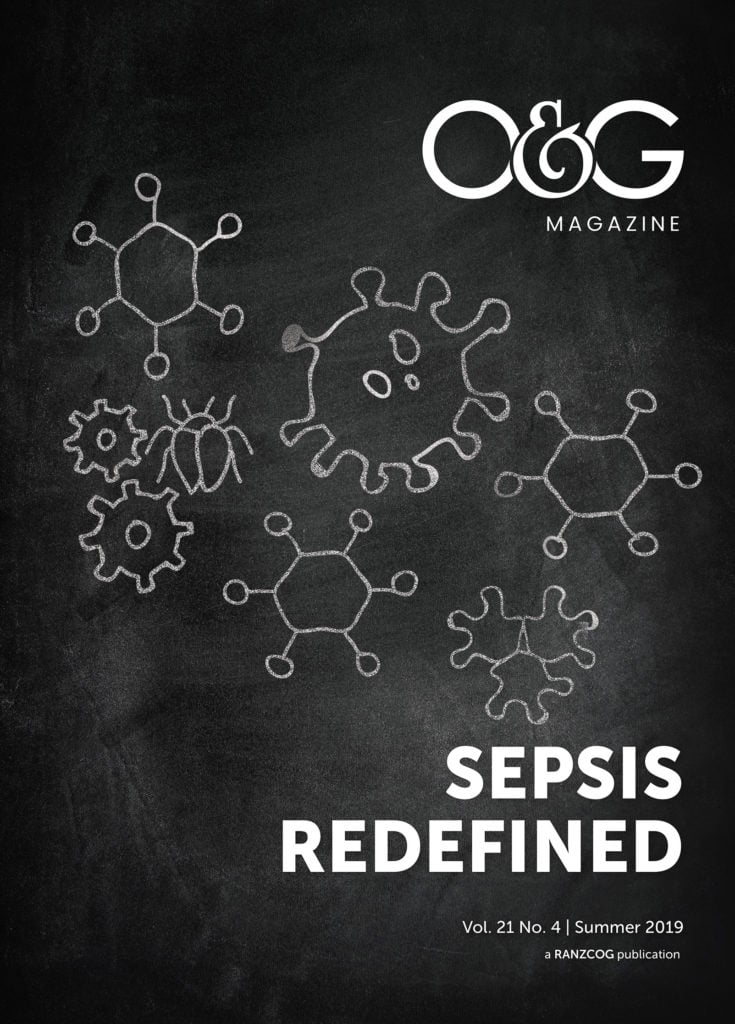Prof Norman Albert Beischer
1930–2015
Prof Norman Albert Beischer AO, MD BS, MGO, FRCS (EDIN), FRCOG, FRACS, FRANZCOG, DMEDSC (HON) was an intellectual giant and visionary who made an enormous contribution to improving women’s health and progressing the science and our knowledge of obstetrics and gynaecology.

Painting of Prof Norman Albert Beischer.
Norman was born in Bendigo, Victoria, on 15 August 1930, and attended the Bendigo State and High schools before completing his education at Geelong Grammar. In 1948, he was awarded the Argus Literature Prize and the Geelong Grammar School Council’s AH Whittingham Scholarship. This love of language and the written word stayed with him all his life and was evident in his later publications. Norman progressed to the University of Melbourne where he graduated MBBS in 1954. During this time, he achieved numerous honours, including the Fulton Scholarship in Obstetrics and Gynaecology, and the Hubert Sydney Jacobs Prize in Clinical Gynaecology, launching his path to obstetrics and gynaecology. His postgraduate training was at the Alfred Hospital, Royal Children’s Hospital and Royal Women’s Hospital from where he obtained his initial training in obstetrics and gynaecology. As was the practice in those times, Norman travelled to Northern Ireland where he worked in Lurgan, Portadown and Ballymoney hospitals, obtaining his membership of the Royal College of Obstetricians & Gynaecologists (MRCOG) and subsequently the Fellowship of the Royal College of Surgeons of Edinburgh (FRCS Ed). While in the UK, Norman met Elizabeth Young whom he married in 1961 and was his life-long partner, the mother of his three children and the love of his life.
On his return to Melbourne in 1965, Norman joined the Department of O&G at the Royal Women’s Hospital as first assistant to Prof Lance Townsend who immediately recognised his enormous potential as a clinician, surgeon and academic. At the time, the Professorial Unit was responsible for the management of cervical cancers within the hospital. Prof Townsend gave Norman the task of performing the Wertheim hysterectomies so that he could become proficient in surgery of the lateral pelvic wall, this being a prerequisite for dealing with obstetric haemorrhage for which he may have been called upon to deal with in the future as a head of department.
In 1968, Norman was appointed the second Professor of O&G at the University of Melbourne following Marshall Allan, the first Professor of Obstetrics, and Lance Townsend who was the first Professor of O&G within the University. In 1969, he worked at the Johns Hopkins Hospital in Baltimore before taking up his appointment at the newly opened Mercy Maternity Hospital, a position he held for 28 years. Over this time, he established the hospital as a first-class facility providing obstetric and gynaecological care for the women of Melbourne. From the outset, he involved every consultant in the hospital in auditing the outcomes of clinical management and produced the triennial report of the hospital, which was widely distributed and set the standard of excellence for a tertiary institution from which all other maternity units within Victoria could be compared. He applied the same meticulous scrutiny to clinical outcomes by sitting on the Consultative Council on Obstetric and Paediatric Morbidity and Mortality, of which he became Chairman from 1984 until his retirement in 1999. Norman was also a member of the National Health and Medical Research Council National Perinatal Statistical Unit, which was responsible for reporting maternal deaths in Australia.
Norman was an exceptional teacher, with students rotating from the Austin Hospital Clinical School being warmly welcomed and enthusiastically taught. He edited several student textbooks, most notably Obstetrics and the Newborn with Eric Mackay from Brisbane, now in its 4th edition, which were easy to read, colourfully illustrated and continue to this day to be standard teaching texts for undergraduates in Australia.
Norman was a passionate researcher, having authored more than 200 publications. He was quick to recognise the need to assess fetal wellbeing in utero in order to reduce perinatal mortality. Utilising the work of Prof James Brown who had developed a bioassay for oestriol, he established a program of routine testing for urinary oestriol excretion in the third trimester to identify those pregnancies at risk of placental insufficiency and intrauterine growth restriction. Innovative in his management, he attempted to improve the intrauterine environment and growth in utero through bed rest and intravenous hyperalimentation, these being the only measures available at the time to allow prolongation of the pregnancy. In order to determine the timing of delivery more precisely for these high-risk pregnancies, he established the Fetal Monitoring Unit, under the supervision of Frank Chew, which used cardiotocography to assess fetal wellbeing in utero. Through these measures and embracing routine ultrasound scanning, he, in effect, established the foundations of the discipline of maternal-fetal medicine well before this was even considered a subspecialty within obstetrics.
Norman was a pioneer in appreciating the importance and effect of hyperglycaemia in pregnancy and implemented routine testing for gestational diabetes mellitus in the third trimester for all antenatal patients. This was at a time when there was no clear policy on antenatal screening with gestational diabetes having a reported low incidence in our community. His recommendation for routine one-step full glucose tolerance testing was over 40 years later accepted by the World Health Organization as the standard of care in obstetrics.
Norman also recognised that gestational diabetes was a marker for the risk of developing type 2 diabetes mellitus and initiated a program of long-term follow up of patients, confirming that a considerable proportion would go on to develop diabetes in later life. He also promoted lifestyle interventions and ran a trial of oral hypoglycaemic to prevent the onset of type 2 diabetes.
Having established the obstetric credentials of the hospital, Norman turned his attention to expanding the gynaecological services, coinciding with a name change of the institution to Mercy Hospital for Women. Realising the need for specialised expertise in the management of gynaecological malignancies, he set up the Gynaecological Oncology Unit and appointed Robert Planner in charge of the unit. Robert aggressively undertook radical surgical and debulking procedures in patients with advanced ovarian malignancies, obtaining superior results at a time when chemotherapy was limited by the paucity of effective drugs. He set up the Urodynamics Clinic appointing Peter Dwyer as clinician in charge, allowing him to further develop his interest in urogynaecology. Norman recognised the rapidly advancing area of laparoscopic surgery in gynaecology and supported Peter Maher in setting up the Minimally Invasive Surgery Unit and funding the fellowship position through the Mercy Maternity Hospital Research Fund. Norman acknowledged the need for other specialist clinics and appointed Graeme Dennerstein to establish the first multidisciplinary Vulvar Diseases Clinic, which provided a unique and essential service within a difficult area of gynaecology. These specialist clinics and the obstetric units under his direct supervision enabled the Mercy Hospital for Women to grow into a first-class facility caring for the women of Victoria and training medical students, future obstetricians, gynaecologists, and subspecialists.
Norman took over from Eric Mackay as Editor of the Australian and New Zealand Journal of Obstetrics and Gynaecology in 1983 and remained in this role until his retirement in 2000. Under his direction, the Journal flourished largely by allowing the publication of many clinical articles often preceded by an Editor’s comment that allowed him to add relevance to even obscure articles and point out the take-home message of the author.
Norman was an excellent clinician who was always supportive of the junior staff. He never felt the need to justify the indication for a caesarean section and stated that the caesarean section rate was always a reflection that at all times the best decision had been made for the care of mothers and babies. Notably, Norman was asked to give his expert opinion at the hearings of William McBride in Sydney where he reviewed many cases of alleged mismanagement and found no cause to substantiate these claims.
Following his retirement from the University Department at the Mercy Hospital for Women, Norman remained active as Chair of the Medical Research Foundation for Women and Babies, founded by him in 1981 as the Mercy Maternity Hospital Research Foundation. The Foundation was renamed the Norman Beischer Medical Research Foundation after his death in 2015, in recognition of his significant contribution to the Foundation and to medical research.
Norman was honoured with the Order of Australia in 2000 with the citation, ‘For service in the field of obstetrics and gynaecology and for clinical research into the causes and prevention of maternal and perinatal deaths’. In 2013, Norman was awarded an Honorary Doctorate of Medical Science from the University of Melbourne in recognition of his contribution to medical research and to the improvement of maternity care which in turn transformed the lives of countless women and their families across the world. He devoted his life to advancing our knowledge of obstetrics and gynaecology and improving the health of mothers and babies. His contribution to our discipline and the influence he had on his colleagues will be enduring and the breadth of his achievements would position him as the last true Professor of O&G, the likes of which will never be seen again.
Dr Salvatore Sfameni
FRANZCOG
Dr Peter Wein
FRANZCOG
Dr Philip Edward Norman Suter
1932–2019
Philip Suter was born in the UK in 1932, graduated there in 1957 and then acquired Fellowship of the RCOG and, later, RANZCOG. Before migrating to Australia in 1976, he worked in London, Germany and Kenya. We met as fellow obstetricians at Essendon and District Memorial Hospital where we managed both public and private patients until its regrettable closure in 1992. Philip was the senior obstetrician at the time. He also had appointments at the Royal Women’s Hospital and the Dermogynaecology Clinic at the Mercy Hospital for Women (one of Prof Beischer’s very successful innovations). After retiring from private practice, he continued at the Royal Women’s Hospital and assisted with private surgery. In addition to being a particularly competent specialist, he was an accomplished musician, having been a church organist in his youth. He was a keen golfer with the Royal Women’s Hospital golf club, which he kept up until his heart surgery this year. He is survived by his partner Erika and Martin, Kate and Helen, the children of his former marriage, along with four grandchildren. A thorough British gentleman, he will be well remembered for his ability in so many areas and his kindness and altruism.
Dr Graeme Dennerstein
FRANZCOG
Dr Eva Irene Popper
1934–2019
Dr Eva Popper was born in Vienna in 1934, the only child of Erna and Felix Popper. Eva was the first female Queensland medical graduate to train and graduate in the specialty of O&G and to become a consultant at the Royal Women’s Hospital in Brisbane.

Dr Eva Irene Popper
She and her parents escaped from the escalating tragedy in Europe in 1938, arriving in Australia in February 1939. Her father had been sponsored by a Queensland senator who arranged for him to get a job at a local cardboard factory. The family lived under the factory manager’s house.
In 1952, Eva commenced the medical course at the University of Queensland with the intention of becoming a paediatrician; however, in fifth year she was introduced to the labour ward and her lifelong love for obstetrics was born.
Eva graduated MBBS in 1957 from the University of Queensland and began two years of rotating internship at the Royal Brisbane Hospital. She applied for a registrarship in O&G at the Royal Brisbane and Royal Women’s Hospitals and, in 1961, became the first woman in Queensland to be granted a position in the specialty.
Although there had been some initial opposition to her appointment by some of the senior consultants, they eventually became accustomed to a female registrar and even admitted that brute force was not a prerequisite for successful training! She had excellent teaching that she passed on to her junior resident staff and medical students with plenty of hands-on experience.
In 1962, Eva travelled to the UK and obtained her MRCOG (London), returning to Brisbane in 1963 where she commenced private practice in O&G, continuing until 1994. At first, referrals from general practitioners were slow as they had no experience of a female specialist consultant, but gradually she overcame this male prejudice and she thoroughly enjoyed her working career.
Eva estimated that she had delivered about 5000 babies, (affectionately referred to as Proper Popper Products) and many of these families became her lifelong friends.
In 1963, Eva was appointed to the Moorooka Antenatal Clinic in Brisbane, followed by appointments as visiting consultant obstetrician to Royal Women’s Hospital (1964–1990) and visiting gynaecologist to Royal Brisbane Hospital (1972–1991). Eva enjoyed teaching and contributed manipulative skills and experience rather than just pure theoretical knowledge. In 1967, she was involved in the formation of a consultative clinic at the Royal Women’s Hospital for the management of Rhesus sensitisation.
Judaism was central to Eva’s life and her contribution to the Jewish community in Brisbane was enormous. In 2009, Eva was awarded the Queensland State Zionist Council’s Rabin Award for her services to the Jewish Community and, in 2010, the Union for Progressive Judaism’s Vatik Award for her services as President and for her long commitment to Progressive Judaism.
Eva had a wide range of interests that included a love of music, the fine arts and literature. She enjoyed bushwalking and birdwatching and was well travelled both overseas as well as within Australia. It was following a trip to Israel in 2015 to see relatives that she was diagnosed with lung cancer (one of the one-in-three women who develop this disease that never smoked). Eva courageously accepted the challenge, but finally succumbed on 2 March 2019. On the plaque mounted over the niche where her ashes are interred are the following words: Loved and missed by her family, friends and the community she served.
Dr Edward John Vesey
FRANZCOG, FRCOG
Dr Paul William Robinson
1966–2019
Dr Paul William Robinson was farewelled and his life celebrated by a large gathering of family, friends and colleagues at Auckland’s Holy Trinity Cathedral.
Paul was the eldest of three boys, born into a farming family and raised in the Waikato. Following a very active rural childhood, he attended St Paul’s Collegiate in Hamilton as a boarder and was head prefect there in his final year. On leaving school, Paul went on to Waikato University and completed a Masters degree in Technical Science. It was while at Waikato that Paul met and married his wife, Michelle.
When Michelle had an opportunity to complete postgraduate study at UCLA in California, Paul travelled as her house husband, before finding some part-time work in a diabetes research laboratory. This stimulated his interest in medicine, and with Michelle’s encouragement, Paul gained entry into the University of Auckland School of Medicine on their return to New Zealand. Life was busy for Paul and Michelle as medical studies were fitted around family life, with the birth of their son Zach, later followed by daughters Meg and Kate.
An interest and aptitude in O&G as a student led to Paul pursuing a career in the specialty. He completed RANZCOG specialist training at National Women’s, Middlemore and Tauranga hospitals before starting work as a specialist at Auckland City Hospital in 2007. Paul was a very able general O&G, with interests in both colposcopy and infertility. He combined his public work with a successful private obstetric practice, working energetically in both capacities.
Ever since boarding school, Paul had been keen on road cycling, a passion that remained throughout his life. He competed in many events, including the nationally renowned Tour of Southland, and had the opportunity to travel overseas to follow both the Tour de France and the Giro d’Italia.
Paul and Michelle were keen supporters of the NZ Gynae Club, attending several enjoyable meetings throughout the Pacific. They were involved at an organisational level and formed strong friendships with colleagues from all around New Zealand.
On being diagnosed with cancer in late 2014, Paul ceased his private practice, but remained a valued part-time member of the senior medical staff at Auckland City Hospital’s O&G department. His preference to remain involved in his work was part of what Paul termed his work-life-treatment balance; alongside a rekindled interest in choral singing and his enthusiastic ownership of both an e-bike and an electric car. To all who knew him, his relentlessly positive attitude was an inspiration.
With a sudden decline in his health, Paul finished work just a few weeks before he died on 30 May 2019.
Paul is survived by his wife Michelle, children Zach, Meg and Kate, and his beloved dog, Cairo.
Dr Tim Dawson
FRANZCOG






Leave a Reply